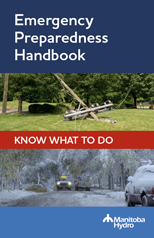Power can be disrupted for a few moments, an hour or two, or in extreme cases such as a severe winter storm, for more than a day. Although we cannot predict a power outage, it is important to be prepared and know what to do when the lights go out.

How to be prepared for a power outage
Watch to learn how you can prepare for an electricity or natural gas outage, including what to put in an emergency kit and how to be safe during an outage.
Video: 2:11
Before an outage occurs
Keep essential items in an emergency box and store it where it will be easy to find in the dark:
- flashlight and extra batteries;
- portable radio and extra batteries;
- portable charger for mobile devices;
- bottled water;
- canned or dried food;
- manual can opener;
- blankets;
- candles and matches;
- first aid kit;
- spare fuses.
What you can do
- If you want to cook during a power outage have extra briquettes or propane on hand for your barbecue.
- Never barbecue indoors or in an enclosed space.
- If you have a natural gas fireplace, make sure it is serviced and working properly. Many natural gas fireplaces will continue to work without electricity.
- If you have a fireplace, keep a supply of firewood available.
Also visit the federal government’s Get Prepared website for more information on how to prepare for a power outage and other emergencies.
During a power outage
Staying warm
- During a winter storm, stay calm. Your house will remain warm for several hours. Avoid opening doors. If you have an alternate heat source, use it before the house cools. Maintain adequate ventilation.
- A power outage may mean your furnace won’t work. Most natural gas furnaces need electricity to operate but may operate the burner without a power source. Refer to your appliance manufacturer instructions.
- Natural gas furnaces do not have to be turned off. They should operate when the power is restored.
Food storage and cooking
- A full freezer will keep food frozen for about 48 hours. A freezer that is half-full will keep food frozen for about 24 hours.
- An unopened refrigerator will keep food cold for about 4 hours. If available, add ice to the refrigerator to keep the food at a safe temperature if the power will be out for a long time.
- Visit the Canadian Food Inspection Agency website for more information about food safety during and after a power outage or other emergencies.
- If you want to cook, be sure to provide adequate ventilation – never barbecue indoors or in an enclosed space.
- Fuel-burning equipment that is not connected to a chimney or vent should not be used indoors. Many appliances generate dangerous levels of carbon monoxide very quickly.
Standby or back up generator
- During a power outage, a properly sized and well-maintained generator can restore electricity within minutes with a manual-start generator or in seconds with an automatic-start unit.
- To prevent carbon monoxide poisoning, never operate your generator in a house, garage, or other enclosed building.
Pipes and appliances
- If pipes are in danger of freezing, turn off the main water valve and drain the line by running taps. Put plumbing antifreeze in toilet bowls, sinks and bathtub drains. Turn off and drain your water heater by connecting a hose to the drainage tap on the tank and empty into the basement drain.
- Turn off all electrical appliances. Pay special attention to those you may have been using when the power went out (such as a stove or oven).
- Unplug electronic equipment to protect it from a voltage surge when power is restored. More about surge protection.
- Keep one light plugged in and turned on, so you will know when the electricity is back on.
- If you are leaving your house during a power outage, turn off the main breaker. This reduces the chance of appliance damage and safety problems if power is restored while you are away.
Emergency Preparedness Handbook
The information in this handbook is offered as a tool to help you plan your personal emergency response.
- Download the Emergency Preparedness Handbook (PDF, 2.1 MB)

